Abstract
The production of winter wheat, spring barley, spring oilseed rape, and field beans requires detailed experimental data studies to analyze the quality and productivity of spring barley grain under different cultivation and tillage conditions. As the world’s population grows, more food is required to maintain a stable food supply chain. For many years, intensive farming systems have been used to meet this need. Today, intensive climate change events and other global environmental challenges are driving a shift towards sustainable use of natural resources and simplified cultivation methods that produce high-quality and productive food. It is important to study different tillage systems in order to understand how these methods can affect the chemical composition and nutritional value of the grain. Both agronomic and economic aspects contribute to the complexity of this field and their analysis will undoubtedly contribute to the development of more efficient agricultural practice models and the promotion of more conscious consumption. An appropriate tillage system should be oriented towards local climatic characteristics and people’s needs. The impact of reduced tillage on these indicators in spring barley production is still insufficiently investigated and requires further analysis at a global level. This study was carried out at Vytautas Magnus University Agriculture Academy (Lithuania) in 2022–2024. Treatments were arranged using a split-plot design. Based on a long-term tillage experiment, five tillage systems were tested: deep and shallow plowing, deep cultivation–chiseling, shallow cultivation–disking, and no-tillage. The results show that in 2022–2024, the hectoliter weight and moisture content of spring barley grains increased, but protein content and germination decreased in shallowly plowed fields. In deep cultivation–chiseling fields, the protein content (0.1–1.1%) of spring barley grains decreased, and in shallow cultivation–disking fields, the moisture content (0.2–0.3%) decreased. In all fields, the simplified tillage systems applied reduced spring barley germination (0.4–16.7%). Tillage systems and meteorological conditions are the two main forces shaping the quality indicators of spring barley grains. Properly selected tillage systems and favorable climatic conditions undoubtedly contribute to better grain properties and higher yields, while reducing the risk of disease spread.
1. Introduction
As the world’s population grows, it is crucial to grow enough produce. As the climate changes, it is difficult to maintain high-quality produce. Spring barley is an important crop in agriculture, as it is widely used for animal feed, food, and malt production. However, the crop is highly susceptible to climate change, which can have a direct impact on both its yield and grain quality parameters. Yield quantity and quality are affected not only by long-term climatic changes but also by short-term adverse meteorological conditions such as drought periods, heavy rains, or temperature fluctuations [1]. In recent years, an increasing number of farms have opted for less intensive, reduced-tillage techniques that reduce input and conserve soil. As a result of this trend, the area under reduced tillage is increasing. Research is active in Europe to assess the impact of conservation tillage systems on soil physical and mechanical properties and greenhouse gas emissions, in particular, CO2 [2]. One of the main objectives of modern agriculture is to reduce the intensity of tillage to preserve soil fertility in the long term and to conserve natural resources, while obtaining quality production. Tillage is a fundamental aspect of agricultural production and the mechanisms that affect crop growth and the soil environment [3]. Reduced tillage, including no tillage, allows for more efficient use of time and financial costs [4], and helps to maintain a higher moisture content in the soil [5,6]. Both the chemical and physical properties of soil determine its fertility potential and plant productivity [7]. Furthermore, heat stress inhibits protein synthesis, starch accumulation, and biosynthetic activity and alters the composition of leaves and grains [8]. An appropriate tillage system should be oriented towards local climatic characteristics and people’s needs [9].
Conservation tillage, including no-till (NT), is a climate-friendly agricultural practice that is being adopted worldwide due to its importance in increasing food security and mitigating climate change [10]. Other researchers have found that reduced tillage includes techniques such as surface tillage, e.g., cultivation of the soil with disk or colter cultivators, no-tillage with minimum tillage, where the soil surface is only cultivated at the point where the seed is inserted, or no-tillage into the stubble. These methods stimulate the biological activity of the soil and improve its structure, allowing it to retain moisture reserves [11], reduce evaporation, and minimize erosion [12]. Consequently, plant productivity and quality indicators are improved [5,13].
Research has shown that deep tillage (or conventional tillage) can temporarily increase crop yields due to rapid soil aeration and weed suppression, which are crucial during critical stages of plant growth [14]. However, its long-term consequences often include soil compaction, which can deteriorate soil structure and reduce water infiltration capacity. The negative effects of deep tillage have been investigated in studies where continuous mechanical soil disturbance has led to erosion and nutrient depletion, which is detrimental to long-term sustainability [15,16]. Furthermore, studies by Machanoff et al. show that conservation tillage practices protect yields and reduce risks associated with extreme weather events, increasing overall crop productivity and quality [17]. Hypothesis: it is likely that conservation tillage systems will improve spring barley productivity and grain quality indicators more effectively than deep-plowing tillage. The choice of the right tillage system is one of the key factors in the formation of healthy and high-quality yields. Objective: to compare the effects of deep-plowing and conservation tillage systems on the productivity and grain quality indicators of spring barley crops.
2. Materials and Methods
2.1. Study Sites
The experimental site is a long-term stationary field experiment at the Experimental Station (54°52′ N, 23°40′ E) of Aleksandras Stulginskis University (since 2019, Vytautas Magnus University, Agriculture Academy), Lithuania. The stationary field experiment was established in 1988 by scientist A. Stancevičius and modified in 2000 by professor V. Bogužas. The station is located on the left bank of the Nemunas River, Ringaudai municipality, Kaunas district, south-western side of Kaunas city. The long-term field experiment is led by V. Bogužas. For more than 20 years, various experimental agronomic research has been carried out here under a uniform and well-established tillage system. The field soil of the experiment is a deeper gleyic saturated loamy soil according to the Lithuanian soil classification (LTDK–99) [17,18,19], and according to the international classification [19] it is Epieutric Endocalcaric Endogleyic Planosol (Endoclayic, Aric, Drainic, Humic, Episiltic) (Table 1 and Table 2) [20]. The most recent soil agrochemical and agrophysical properties are indicated by A. Sinkevičienė and other authors, 2024 [21].

Table 1.
Experiment soil (Epieutric Endocalcaric Endogleyic Planosol) agrochemical, agrophysical properties, 1997 (according to D. Jodaugienė, 2002 [7]).

Table 2.
Agrotechnical measures and timing for spring barley cultivation.
Experimental design and agricultural practices:
1. Normal deep plowing at a depth of 23–25 cm (DP) (control–comparative variant);
2. Shallow plowing at a depth of 12–14 cm (SP);
3. Deep cultivation–chiseling (with a cultivator with arrow-shaped cultivator points) at a depth of 23–25 cm (DC);
4. Shallow cultivation–disking (with a disk cultivator) at a depth of 8–10 cm (SC);
5. No-tillage (NT).
Crop rotation in the experiment: (1) winter oilseed rape; (2) winter wheat; (3) beans; (4) spring barley.
The experiment was set up in four replicates. The initial size of the fields was 126 m2 (14 × 9 m) and the reference size was 70 m2 (10 × 7 m). The experimental fields were laid out in a randomized manner. The total number of fields in the experiment was 20. The buffer zone was 1 m wide per field and 9 m wide between replicates.
2.2. Meteorological Conditions
In 2022, April was colder (6.2 °C) and drier (33.7 mm) than the long-term average. The precipitation at the beginning (121.6 mm in May) and at the end (122.2 mm in August) of the crop vegetation period was higher (59.9 mm and 33.3 mm, respectively), and the temperature (11.0 °C in May) was lower than the long-term average (2.2 °C). The temperature in August (20.9 °C) was higher than the long-term average (3.6 °C). In June and July, precipitation was less than the multi-year average. In June, the temperature was 17.7 °C, and in July, it was 17.9 °C (Figure 1 and Figure 2).

Figure 1.
Average precipitation at Kaunas Meteorological Station in 2022–2024.
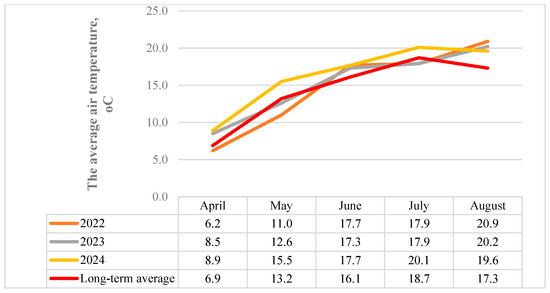
Figure 2.
Average air temperature at Kaunas Meteorological Station in 2022–2024.
In the study year, precipitation in April, June, and July was below the multi-year average. Temperatures were higher in April and June, but fell below the multi-year average in July. In 2023, precipitation at the beginning of the crop vegetation period in May was 14.3 mm lower and in August it was 96.2 mm higher than the long-term average (47.4 and 7.3 mm). Temperature (12.6 °C in May) was lower than the long-term average (0.6 °C), while at the end of the vegetation period in August, the temperature (20.2 °C) was higher than the long-term average (2.9 °C) (Figure 1 and Figure 2).
In 2024, the months of April and July were characterized by higher temperatures and higher precipitation compared to the multi-year average. June was warmer, but precipitation was less than half (36.8 mm) the multi-year average (76.9 mm). The precipitation at the beginning (25.1 mm in May) and at the end (40.9 mm in August) of the crop vegetation period was lower (36.6 and 48.0 mm), and the temperature (15.5 °C in May to 20.1 °C in August) was higher than the long-term average (2.3 and 1.4).
Summarizing the meteorological conditions for the study years, the 2022–2023 study years show higher precipitation in August and lower precipitation in June and July compared to the long-term average. Over the whole study period, the most abundant precipitation was in May 2022, July 2024, and August 2022 and 2023 (Figure 1 and Figure 2). In 2022–2024, temperatures were highest in June and August compared to the long-term average.
2.3. Crop Productivity and Quality Indicators
Crop germination: Germination was determined once—on the tenth day after the beginning of germination (BBCH 10). In each field, the density of seedlings was counted at ten randomly selected points in a 1 m long row. Seedling density was converted into pieces m−2.
Seedling density: For spring barley (number of productive stems), this was determined at maturity, in 50 × 50 cm frames, at 4 locations in the field, and expressed in pieces m−2.
Determination of grain yield, t ha−1: The grain yield of each field was calculated using a computerized weighing system on the combine harvester. Yields were converted at 14% moisture content into absolute clean weight of grain.
Determination of grain quality: Grain quality parameters were determined in the laboratory of the elevator in Radžiūnai, Alytus district. Methods for determining quality indicators were as follow:
- Protein content: the method is given in standard LST EN ISO 12099 (Lithuanian Standardization Department, Lithuania, Vilnius, 2025 (http://www.lsd.lt)) “Determination of protein content of whole barley by near-infrared spectroscopy”, “INFRATEC 1241” from FOSS.
- Starch content (%) was determined by Ewers polarimetric method, “INFRATEC 1241” device from FOSS, in standard LST 1797:2024 (Lithuanian Standardization Department, Lithuania, Vilnius, 2025 (http://www.lsd.lt)).
- Hectoliter mass (kg hl−1) was determined using infrared spectroscopy method, “INFRATEC 1241” from FOSS, in standard LST EN ISO 7971-3 (Lithuanian Standardization Department, Lithuania, Vilnius, 2025 (http://www.lsd.lt)).
- Grain moisture content (%) was determined using the infrared spectroscopy method, “INFRATEC 1241” from FOSS, in standard LST EN ISO 712 (Lithuanian Standardization Department, Lithuania, Vilnius, 2025 (http://www.lsd.lt)).
2.4. Comprehensive Evaluation
A comprehensive assessment of the impact of tillage technologies of varying intensities on the agroecosystem was conducted using the methodologies developed by G. Lohmann (1994) and K. U. Heyland (1998) [22,23]. The following studies and mathematical calculations were carried out: (1) Determining the values of different indicators. (2) Calculating the evaluation points (EPs) of the different indicators expressed in different units of measurement to convert the values into a single scale. On this scale, a score of 1 represents the poorest (minimum) value, while a score of 9 reflects the best (optimum) value. Intermediate scores for each indicator were calculated using the following formula:
where EPi represents the evaluation point for a given indicator; Xi is the observed value of that indicator; Xmax and Xmin are the maximum and minimum values recorded for that indicator, respectively. (3) The converted indicator values are presented on radial grids, with the radius scaled from 1 to 9, reflecting the evaluation points. (4) The scale also shows the average value of the individual indicators—the score threshold—which is equal to 5 and distinguishes between the high and the low scores. The effectiveness of the measure will be indicated by the area bounded by the scores of all its indicators. (5) The complex evaluation index (CEI), which consists of the average of the evaluation points, the standard deviation of the evaluation points, and the standard deviation of the average of the points below the evaluation threshold, is calculated.
EPi = (Xi − Xmin) · (Xmax − Xmin) − 1 · 8 + 1,
2.5. Statistical Analysis
The research data were analyzed using a one-way analysis of variance (ANOVA) applying the F test via the SPSS Statistics I software package e (version 22; SPSS Inc., Chicago, IL, USA) [24]. The research data were processed by the method of analysis of variance using the computer program SYSTAT 12. Differences between the means of the treatment variants were evaluated using the Least Significant Difference (LSD) test at confidence levels of 95.99% and 99.90%. Correlations between variables were assessed using correlation analysis, which involved calculating the correlation coefficient (r) and its statistical significance at 95% and 99% probability levels. Regression equations were also generated using the STAT program from the SELECTION software package [25].
Standard errors of the means are represented by whiskers on the graphs. Statistically significant differences between a given treatment and the control are marked with confidence levels as follows:
* for p ≤ 0.050 > 0.010 (the differences are significant at the 95% confidence level);
** for p ≤ 0.010 > 0.001 (differences are significant at the 99% confidence level);
*** for p ≤ 0.001 (differences are significant at the 99.99% confidence level);
p > 0.050, no significant differences (differences significant at less than 95% confidence level).
3. Results
3.1. Crop Productivity Indicators
In 2022, when calculated after 10 days, the crop germination did not differ significantly between tillage systems. Reduced-tillage systems (SP, DC, SC, NT) reduced crop emergence by 4.50 to 16.69% compared to deep plowing (DP) (Figure 3).
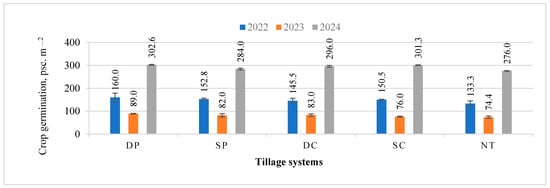
Figure 3.
Spring barley crop germination after 10 days, under different tillage systems, 2022–2024. Note: DP—Deep plowing, SP—Shallow plowing, DC—Deep cultivation–chiseling, SC—Shallow cultivation–disking, NT—No-tillage. No significant differences at p > 0.05. Whiskers indicate standard errors of the means.
In 2023, when calculated after ten days, reduced tillage (SP, DC, SC, NT) reduced crop emergence by 6.74 to 16.40%. Conventional tillage (DP) increased crop germination.
In 2024, all reduced-tillage practices (SP, DC, SC, NT) reduced spring barley crop germination by 0.44 to 8.81% compared to deep plowing (DP). The lowest spring barley germination was found in direct sowing into no-till fields (NT).
All of the reduced-tillage systems reduced the germination (0.4–16.7%) of spring barley crops in the years 2022–2024.
In 2024, a linear, average negative, and statistically significant correlation was established between the germination of the spring barley crop (r = −0.543, y = 669.047 − 4.526x, p < 0.05) and the number of productive stems.
Calculations carried out in 2022 showed that there was no significant effect on crop density under the different tillage systems (Figure 4). Reduced tillage increased crop density by up to 12.44% compared to deep plowing (DP). Shallow-plowing (SP), chiseled (DC), and disked (SC) fields showed a higher crop density of up to 11.94% higher than in fields with conventional tillage. In the directly sown (NT) fields (400 pieces m−2), the crop density was very similar to that in the deep-plowing (DP) fields (402 pieces m−2).
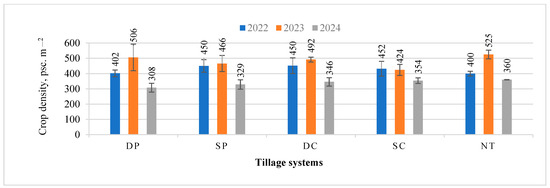
Figure 4.
Spring barley crop density under different tillage systems, 2022–2024. Note: DP—Deep plowing, SP—Shallow plowing, DC—Deep cultivation–chiseling, SC—Shallow cultivation–disking, NT—No-tillage. No significant differences at p > 0.05. Whiskers indicate standard errors of the means.
The calculations carried out for 2023 showed that no significant effect on crop density was observed with the different tillage systems. The highest crop density was found in direct no-tillage (NT) fields with 525 pieces m−2 and the lowest density was found in fields with shallow cultivation (SC) with 424 pieces m−2. Different tillage treatments had different effects on crop density (Figure 4).
The analysis of the number of productive stems of the spring barley crop showed that all the reduced-tillage treatments increased the number of productive stems by between 6.92 and 16.88% compared to the control (DP). The highest number of productive stems of spring barley was found in the directly sown fields (NT) (Figure 4).
In 2022 and 2024, the reduced-tillage systems (SP, DC, SC) increased the density of the spring barley crop, while in 2023 they decreased it. The application of no-tillage (NT) decreased the spring barley density in 2022 and increased it in 2023–2024.
In 2022, the analysis showed that different tillage effects had a significant impact on spring barley yields (Figure 5). Conventional tillage resulted in a maximum grain yield of 7.2 t ha−1 for spring barley.
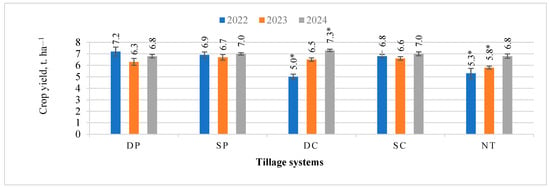
Figure 5.
Spring barley crop yield under different tillage systems, 2022–2024. Note: DP—Deep plowing, SP—Shallow plowing, DC—Deep cultivation–chiseling, SC—Shallow cultivation–disking, NT—No-tillage. Differences significant at *—p ≤ 0.05 > 0.01. Whiskers indicate standard errors of the means.
In all fields with reduced-tillage systems, spring barley yields decreased by a factor of 1.0 to 1.4 compared to deep-plowing (DP) fields. The lowest yield of 5.00 t ha−1 was found in the deep-cultivation fields. Deep-cultivation (DC) technology resulted in a 30.56% decrease in spring barley yield compared to the deep-plowing (DP) technology. No-tillage (NT) technology resulted in a yield reduction in spring barley of about 2 tons, or 26.39%, compared to deep plowing (DP).
In 2023, the evaluation of the effect of different tillage technologies on spring barley yields shows that, in all fields, the use of reduced-tillage technologies increased spring barley yields compared to deep-plowing fields, except for the no-tillage (NT) fields, where spring barley yields were significantly lower (by 7.94%) compared to the deep-plowing (DP) fields (Figure 5). In 2023, significantly the lowest spring barley grain yields were found in the no-tillage (NT) fields.
The calculation of spring barley yields for 2024 shows a trend toward higher yields with reduced tillage. However, there was a significant increase in yield of 7.35% in the deep-cultivation (DC) fields compared to the control (DP). The lowest yields were found in fields where no-tillage (NT) was applied.
In 2023, a linear, mediocre positive, and statistically reliable correlation was established between spring barley grain yield (r = 0.507, y = 35.51 + 3.543x, p < 0.05) and hectoliter weight.
In 2024, a linear, mediocre negative, and statistically significant correlation was established between spring barley grain yield (r = −0.545, y = 19.29 − 1.027x, p < 0.05) and protein content.
In 2022, all the reduced-tillage systems (SP, DC, SC, NT) decreased the yield of the spring barley crop. In the years 2023–2024, the tillage systems (SP, DC, SC) increased the yield of the spring barley crop. The application of no-tillage (NT) decreased the yield of spring barley in all the years studied.
3.2. Quality Indicators of Spring Barley
Based on the data from the 2022 survey, it can be concluded that the different tillage practices did not have a significant effect on the grain protein content. The results show that the fields with conventional tillage had the highest protein content compared to the reduced-tillage systems (Figure 6). Grain protein content in the years studied was low at 10.1%, equivalent to Grade 3 in terms of grain quality indicators.
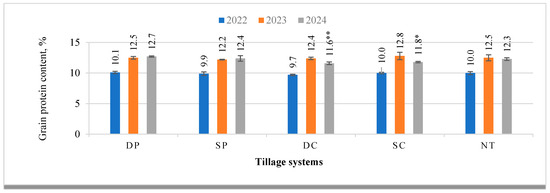
Figure 6.
Protein content of spring barley grains under different tillage systems, 2022–2024. Note: DP—Deep plowing, SP—Shallow plowing, DC—Deep cultivation–chiseling, SC—Shallow cultivation–disking, NT—No-tillage. Differences significant at *—p ≤ 0.05 > 0.01, **—p ≤ 0.01 > 0.001. Whiskers indicate standard errors of the means.
In 2023, the study found that the grain protein content was 0.3% higher in fields with shallow cultivation (SC) compared to deep plowing (DP).
In 2024, the analysis of spring barley grain quality showed a significant decrease of 0.11 and 0.90% in protein content in the deep cultivation (DC) and shallow cultivation–disking (SC) fields compared to the deep plowing (DP) (Figure 6).
In 2022–2024, the reduced-tillage systems (SP, DC, SC, NT) reduced the grain protein content of the spring barley crop, except for shallow cultivation (SC) in 2023. In 2023, when SC was applied, the starch content of the grain increased.
In 2022, a linear, mediocre negative, and significant reliable correlation was established between the protein content of spring barley grains (r = −0.576, y = 67.995 − 0.549x, p < 0.01) and starch content.
In 2023, a linear, very strong negative, and significant reliable correlation was established between the protein content of spring barley grains (r = −0.9, y = 72.453 − 0.876x, p < 0.01) and starch content.
In 2024, a linear, strong negative, and statistically reliable correlation was established between the protein content of spring barley grains (r = −0.733, y = 65.504 − 0.353x, p < 0.01) and starch content.
The starch analysis in 2022 showed that the starch content was 0.6% higher in the fields with deep cultivation (DC) compared to the fields with conventional plowing (DP) (Figure 7). Reduced tillage did not have a significant effect on the grain starch content.
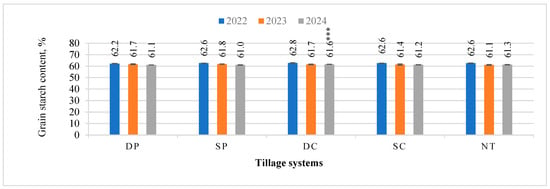
Figure 7.
Starch content of spring barley grains under different tillage systems, 2022–2024. Note: DP—Deep plowing, SP—Shallow plowing, DC—Deep cultivation–chiseling, SC—Shallow cultivation–disking, NT—No-tillage. Differences significant at ***—p ≤ 0.001. Whiskers indicate standard errors of the means.
The starch analysis in 2023 showed that the fields with shallow plowing (SP) had the highest starch content (61.8%). Other reduced-tillage systems reduced the starch content by up to 0.6% compared to conventional tillage (DP). Summarizing the results of 2022 and 2023, it can be stated that shallow plowing (SP) increased the grain starch content.
In 2024, a significant increase of 0.5% in starch content was observed in the deep-cultivated (DC) fields compared to the control (DP) (Figure 7).
In 2023, a linear, mediocre positive, and significant reliable correlation was established between spring barley grain yield (r = 0.555, y = 55.39 + 0.957x, p < 0.05) and starch content.
In 2023, a linear, very strong positive, and significant reliable correlation was established between the starch content of spring barley grains (r = 0.91, y = −192.382 + 4.082x, p < 0.01) and hectoliter weight.
In 2024, a linear, mediocre positive, and statistically significant correlation was established between the starch content of spring barley grains (r = 0.508, y = 58.012 + 0.461x, p < 0.05) and yield.
The analysis showed that no significant differences were found in 2022 in the fields with different tillage technologies. Reduced tillage increased the hectoliter mass of spring barley grain by 2.7% to 5.7% compared to fields with deep plowing (DP) (Figure 8). The highest spring barley hectoliter mass was found in the deep-cultivated (DC) and shallow-cultivated (SC) fields at 59.7 kg hl−1.
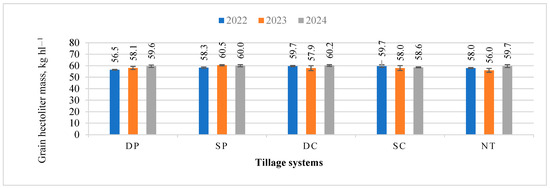
Figure 8.
Hectoliter mass of spring barley grain under different tillage systems, 2022–2024. Note: DP—Deep plowing, SP—Shallow plowing, DC—Deep cultivation–chiseling, SC—Shallow cultivation–disking, NT—No-tillage. No significant differences at p > 0.05. Whiskers indicate standard errors of the means.
The data from 2023 showed that spring barley hectoliter mass was highest in the shallow-plowed (SP) fields, with a result up to 4.1% higher compared to conventional plowing (DP). Barley is classified as high-quality when the hectoliter mass is 60.0 kg hl−1 and above, and poor-quality when it is lower. The hectoliter mass of spring barley grain is variable under different reduced-tillage systems.
In 2024, shallow plowing (SP), deep cultivation (DC), and no-tillage (NT) resulted in a higher grain hectoliter mass of up to 1.0% compared to deep-plowed (DP) fields.
In 2022, a linear, mediocre positive, and significant reliable correlation was established between spring barley grain yield (r = 0.618, y = 47.093 + 1.751x, p < 0.01) and hectoliter weight.
In 2023, a linear, strong negative, and significant reliable correlation was established between the protein content of spring barley grains (r = −0.794, y = 102.035 − 3.469x, p < 0.01) and hectoliter weight.
In all the years studied (2022–2024), shallow plowing (SP) showed an increase in spring barley grain hectoliter mass. All other reduced-tillage systems used did not show clear trends.
In 2022, no significant differences in spring barley grain moisture content were detected in the fields with different tillage systems (Figure 9). Shallow-plowing (SP) fields maintained the highest grain moisture content (13.8%). In all the fields studied, the grain moisture content in 2022 was good, and the grain was storable and dry.
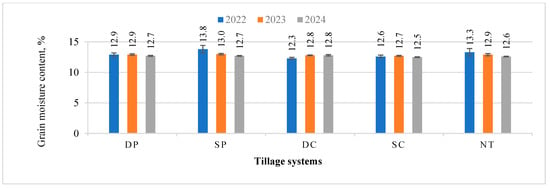
Figure 9.
Spring barley grain moisture content under different tillage systems, 2022–2024. Note: DP—Deep plowing, SP—Shallow plowing, DC—Deep cultivation–chiseling, SC—Shallow cultivation–disking, NT—No-tillage. No significant differences at p > 0.05. Whiskers indicate standard errors of the means.
No significant differences in the moisture content of spring barley grain were found between the different tillage systems in the 2023–2024 period. In 2023, the wettest grain remained in the shallow-plowed fields. In the fields, the grain moisture content did not exceed 13.0%, indicating that the production was suitable for storage, a trend that was also evident in 2024.
In the years 2022–2023, shallow plowing (SP) increased the yield of spring barley grain, while shallow cultivation (SC) decreased it. All other conservation tillage systems (DC, NT) did not show consistent trends.
In summary, in 2022, shallow plowing (SP), deep cultivation (DC), and shallow cultivation (SC) increased the starch content and the hectoliter mass of spring barley but decreased the germination and yield of the crop and the grain‘s protein content. In 2023, deep cultivation (DC) increased grain yield. In 2024, the analysis of spring barley crop germination showed that the fields under no-tillage (NT) had the lowest emergence compared to the fields under deep plowing (DP). However, in the no-tillage fields (NT), the number of productive stems was higher compared to the fields with conventional tillage (DP). In the fields with deep cultivation (DC), the highest yields were found but the protein content was lower compared to deep plowing (DP).
In 2022, a linear, mediocre negative, and significant reliable correlation was established between spring barley grain moisture content (r = −0.611, y = 75.465 − 1.311x, p < 0.01) and hectoliter weight.
3.3. Comprehensive Evaluation of the Long-Term Effects of Tillage Technologies on the Agroecosystem
The most important objective of tillage is to minimize the intensive technological impact on the soil and crops and to create the right conditions for them to grow, to ensure a steady renewal of the soil‘s productivity, and to maintain cost-effective production. Continuous deep plowing adversely affects many soil properties and promotes compaction of the subsoil [26]. Each tillage technology has its advantages and disadvantages. Deep plowing has a high probability of producing higher yields. However, due to the low productivity of tillage operations and the need for high-powered implements, these tillage technologies are the most expensive. In addition, deep plowing has negative impacts on the environment, soil, and biodiversity [27]. It is very difficult to decide which indicator has a greater or lesser impact on the crop agroecosystem. An integrated assessment system would solve this problem.
The results of the integrated assessment of the long-term impact of tillage technologies on the agroecosystem, taking into account seven indicators, are presented in the figures below (Figure 10, Figure 11, Figure 12 and Figure 13).
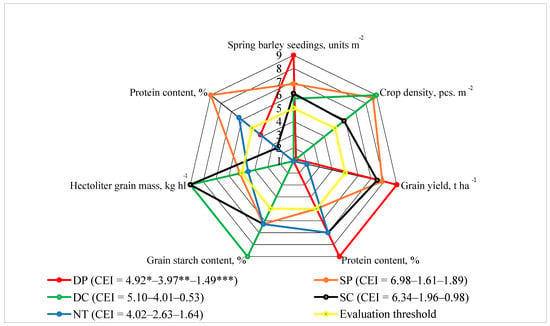
Figure 10.
Complex assessment of long-term effects of tillage technologies 2022. Note: DP—Deep plowing, SP—Shallow plowing, DC—Deep cultivation–chiseling, SC—Shallow cultivation–disking, NT—No-tillage. CEI—complex evaluation indices, *—an average of evaluation points (EPs), **—standard deviation of EPs, ***—standard deviation of the average of the evaluation points below the evaluation threshold.
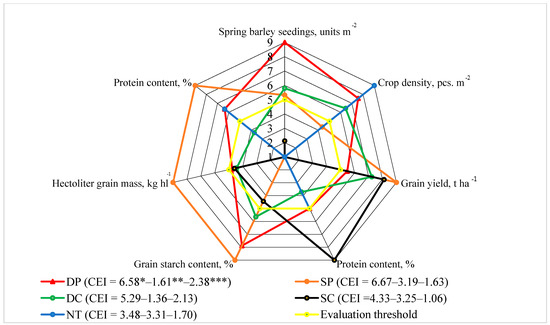
Figure 11.
Complex assessment of long-term effects of tillage technologies 2023. Note: DP—Deep plowing, SP—Shallow plowing, DC—Deep cultivation–chiseling, SC—Shallow cultivation–disking, NT—No-tillage. CEI—complex evaluation indices, *—an average of evaluation points (EPs), **—standard deviation of EPs, ***—standard deviation of the average of the evaluation points below the evaluation threshold.
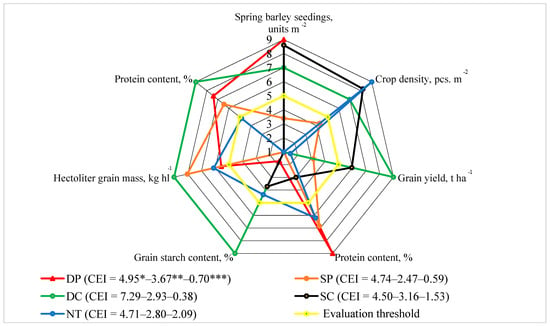
Figure 12.
Complex assessment of long-term effects of tillage technologies 2024. Note: DP—Deep plowing, SP—Shallow plowing, DC—Deep cultivation–chiseling, SC—Shallow cultivation–disking, NT—No-tillage. CEI—complex evaluation indices, *—an average of evaluation points (EPs), **—standard deviation of EPs, ***—standard deviation of the average of the evaluation points below the evaluation threshold.
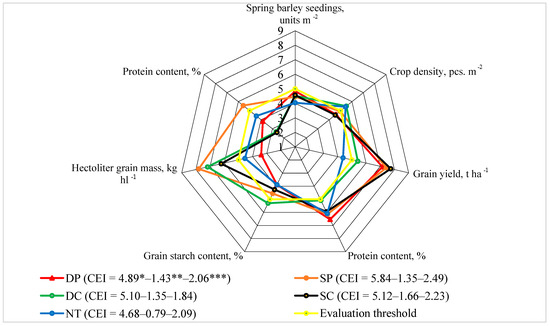
Figure 13.
Complex assessment of long-term effects of tillage technologies 2022–2024. Note: DP—Deep plowing, SP—Shallow plowing, DC—Deep cultivation–chiseling, SC—Shallow cultivation–disking, NT—No-tillage. CEI—complex evaluation indices, *—an average of evaluation points (EPs), **—standard deviation of EPs, ***—standard deviation of the average of the evaluation points below the evaluation threshold.
In 2022, the evaluation of the indicators studied in the spring barley crop showed that the shallow-plowing (SP) tillage technique was superior to the other techniques used, as all the indicators studied were above the assessment threshold (5 points) (Figure 10). Deep-cultivation (DC) and shallow-cultivation (SC) technologies had a more positive impact on the hectoliter mass of spring barley grain, with the highest scores obtained (9 points).
In 2023, the deep-plowing (DP) technology scored higher or close to the assessment threshold (4.76) (Figure 11). For spring barley, a hectoliter mass of grain below the assessment threshold of 4.76 points was found for deep-plowing technology.
Shallow-plowing (SP) technology increased spring barley grain yield, starch content, protein content, and hectoliter mass, with a score threshold of 9 points.
In 2024, different tillage technologies and the evaluation of the indicators under study resulted in different evaluation scores (Figure 12).
When the impact of the technologies on the different indicators studied was assessed, no-tillage technology increased the scores to bring all the indicators studied above the assessment threshold. The deep-cultivation (DC) technology increased spring barley grain yield, starch content, protein content, and hectoliter mass, and the evaluation threshold increased to 9 points.
The calculated complex evaluation indices and areas limited by assessment scores for 2022–2024 showed that the impact of shallow-cultivation (SC) technology on the agroecosystem was greater than that of the other compared technologies (Figure 13).
Summary: The calculated complex evaluation indices (CEIs), consisting of the average, standard deviation, and CEIs of all evaluation points (EPs) not exceeding the evaluation threshold, standard deviation, and areas limited by EPs, show that the positive impact of reduced-tillage technologies on the agroecosystem is greater than that of deep-plowing technologies.
4. Discussion
4.1. Crop Productivity Under Different Tillage Systems
The climate of much of Northern and Western Europe is characterized by low rainfall intensity, long, wet winters, late and often wet springs, cool, humid summers, and an early return of autumn rains, sometimes before harvest or even the start of the harvest [28]. The changing climate affects the countries of Northern Europe, which includes Lithuania, and inevitably affects the productivity of agricultural plants. The physiological processes of cultivated plants that control the phenological characteristics of the plant are adapted to natural climatic conditions [29]. Our research results show that in all the years under study, June was warmer and drier than the multi-year average. This affected the quality indicators of spring barley, and protein content deteriorated. Similar results were obtained by other researchers. Mahalingam et al. [30] state that barley plants that experienced a combination of heat and drought stress, especially at the flowering stage, showed a significant decrease in yield and deterioration in quality, including changes in protein profiles. Meteorological conditions play an important role in the starch formation process. Obviously, climatic factors such as temperature and humidity levels have a decisive influence on barley growth and, consequently, starch content. Studies show that optimal growth temperatures (15–20 °C) help ensure efficient photosynthesis and starch production [31]. Conversely, high temperatures can reduce the plant’s potential to synthesize starch, which will negatively affect grain quality. In our study year, meteorological conditions were optimal, with temperatures ranging from 17.3 to 20.9 degrees Celsius in June-August for the spring barley growth period. Optimal environmental conditions are necessary for the growth and development of cultivated plants and physiological processes. The productivity of crop biomass depends on the optimal operation of the plant’s photosynthetic system [32]. Crop density determines yield and crop productivity [33]. Crop density affects the light extinction coefficient and its distribution in the crop [34]. The denser the crop, the less light falls on each plant, which reduces carbon fixation. Cultivated plants begin to grow more slowly, and the size of some of their organs may decrease [35]. Our research results show that the number of productive stems of spring barley increased (2024) when all conservation tillage systems were applied, compared to deep tillage. Similar results have been obtained by other researchers. Conservation tillage systems can have a positive impact on the number of crop stalks and overall production, but they also pose risks, with disease outbreaks and weeds [36]. The leaf index is determined by the amount of photosynthetically active radiation absorbed by the plant, its spatial arrangement, the amount and ratio of photosynthetic pigments, and the angle of inclination to the sun [37]. Under adverse environmental factors, the productivity of cultivated plants decreases, and the quality of production deteriorates. Grain quality indicators are determined by the genetic potential of the variety, environmental conditions, applied cultivation agrotechnics, and soil [38].
Quite a few factors determine crop density. Our results show that in all years of study (2022–2024) spring barley crop germination was lower when using conservative tillage systems; similar results have been obtained by other researchers. Long-term experiments, analyzing data from trials with similar systems, show that conservation tillage systems can reduce crop germination success [39]. In more weedy fields, we will have a lower crop density, because weeds prevent wheat from growing and developing normally, and competition arises for nutrients, light, and moisture [40].
Choosing reduced tillage and no-tillage (NT) into uncultivated soil, abandoning plowing and deep cultivation, increases the number of weeds [5,41]. To form a dense crop with many productive stems after reduced tillage, sowing at the optimal time and using herbicides is necessary [42]. Seed germination determines the crop density, the number of productive stems, the number of grains per ear, and the weight of 1000 grains. These listed indicators are also determined by environmental conditions, the prevailing soil type, and the applied agrotechnical measures [43].
Allelopathic processes occurring in agroecosystems affect crop productivity, the preservation of genetic diversity, and at the same time the naturally occurring control of weeds and pests [44]. The formation of productive stems of spring barley is also conditioned by sufficient supply of nutrients, favorable environmental conditions, light, weediness of the crop, etc. If the conditions are favorable at that time, the plant forms enough productive stems [45].
Spring barley grain is harvested when the plants reach hard or full maturity. According to research conducted in 2005–2006 at the Bariūnai Agricultural Company, the yield of spring barley decreases when the harvest time is delayed by 5–15 days, from 4.26 to 14.18%, respectively [46]. It is known that grain yield is influenced not only by the time of harvest but also by different tillage technologies used. The best crop yield potential is achieved when plants can grow and develop in favorable environmental conditions [47]. In 2022, our research results showed that all conservation tillage systems reduced spring barley yields, and other researchers have reached the same conclusions. Our 2023–2024 research results showed mixed results. In those years, conservation tillage systems either reduced or increased yields. Other researchers have found that conservation tillage methods can improve spring barley yields if weed control and soil weather conditions are properly considered [48]. Applying different agrotechnical measures creates more favorable conditions for plant productivity and at the same time improves photosynthesis by plants [49].
4.2. Crop Quality Indicators
The protein content in spring barley is determined by many factors that are quite closely related to each other. Typically, the chemical composition of spring barley contains about 12% protein [50]. The protein content in grains determines the nitrogen supply of plants. The main factors are the amount and timing of nitrogen fertilizer use, the time of harvest, and climatic conditions during the vegetation period. Spring barley contains a significant amount of protein and starch in its chemical composition, which allows the grown raw material to be used for full-fledged feed production [51]. Scientist Kinderienė states that conservation tillage can increase soil moisture content, improving plant growth conditions and potentially increasing grain protein content, but our data from 2022 and 2024 show the opposite results [39]. Starch in spring barley is found in about 60.5–65.2% of dry matter. Abdel et al. noted that starch composition and homogeneity can vary significantly depending on meteorological conditions, which can affect the utilization potential of grains [52]. For example, lack of moisture can reduce starch content or change its structure, thereby reducing the nutritional value of grains. The starch content of spring barley (Hordeum Vulgare) grains is an essential quality indicator, especially in terms of millability and usefulness. The starch content in the highest quality barley grains should range from 60% to 65% (by dry weight). However, these levels may vary depending on growing conditions, soil nutrition, and meteorological conditions. The obtained research results in all the research years show that the starch content of spring barley ranged from 61.0 percent to 62.8 percent. These results correspond to the best quality indicators [53]. According to G. Juodeikienė et al. [54], starch in barley is approximately the same as in rye. The gelatinization temperature of barley starch reaches 51–60 °C. The amylose content in barley starch varies from 0 to 45%, depending on the variety. Barley starch is similar in appearance to wheat starch, but it has fewer small granules. In addition, two types of starch granules have been identified in barley (as well as wheat and corn)—A and B granules. These granules are round or elliptical in shape. Starch consisting of large elliptical type A granules and small round type B granules may contain 22–23% amylose or a high amylopectin content. Starch consisting of smaller type A granules and larger type B granules contains a high amylose content (more than 22–23%). The optimal moisture content of spring barley grains should be about 14%, but at a moisture content higher than 14.6%, the grains transition from the dormant period to the execution of biological processes, thus deteriorating the quality of the stored crop [55]. The harvesting of grains may determine the quality of their indicators. According to the literature, the hectoliter mass of grain may decrease with delayed harvest because the surface of grains that dry out and rewet becomes rough and, when measuring the hectoliter mass, they do not fill the measuring vessel as compactly as the grains of barley that were filled on time [56]. Hectoliter or otherwise-measured mass shows how much 1l of spring barley weighs in grams; usually, measured mass is expressed in hectoliter per kilogram [57,58]. Based on the LST 1797:2003 standard and considering the quality indicator of the hectoliter mass of purchased or supplied barley, barley can be of class 1 (food) and the hectoliter mass can reach 62 kg hl−1, while for class 2 (feed) barley, the hectoliter mass in grains is not limited. The safe moisture content suitable for long-term storage of barley grains is 14% or less [55]. In grains with a moisture content of ≤13.0%, the probability of toxin accumulation is reduced even if toxin producers are present [59].
Tillage is among the most energy-intensive and expensive processes in agricultural production. When applying minimal tillage, the moisture content is often not optimal, which can make it more difficult for crops to absorb phosphorus and other nutrients, which can lead to a deterioration in crop productivity and quality indicators. When there is a lack of moisture on the soil surface [60,61], this effect often becomes apparent only in long-term field experiments. The changing climate has an impact on the countries of Northern Europe, which includes Lithuania, and inevitably affects the productivity of agricultural plants. The physiological processes of cultivated plants that control the phenological characteristics of the plant are adapted to natural climatic conditions [29]. Optimal environmental conditions are necessary for the growth and development of cultivated plants and physiological processes [62,63]. The productivity of crop biomass depends on the optimal operation of the plant’s photosynthesis system [32]. Crop density determines yield and crop productivity [33]. In the presence of unfavorable environmental factors, the productivity of cultivated plants decreases, and the quality of production deteriorates. Grain quality indicators are determined by the genetic potential of the variety, environmental conditions, and the applied agricultural techniques for tillage and cultivation, as well as the soil [38]. The yield results presented in the scientific literature using minimum tillage are quite contradictory. Long-term (8-year) scientific studies conducted in Great Britain show that using no-tillage into uncultivated soil reduced the yield of spring barley by 15% compared to deep-plowing technology [64,65]. Other scientists claim that using no-tillage into uncultivated soil resulted in a similar yield of winter wheat to that of deep-plowing fields [6]. Cesevičius et al. [66] claim that in no-tillage fields, the yield of spring barley decreased by 8.5% compared to traditional tillage.
The reaction of plants to environmental factors depends on many components: soil properties, air temperature, mineral nutrition, water regime, light, plant species, variety, physiological state, and selected tillage [67]. Higher air temperature accelerates plant growth, shortens development duration, and reduces productivity [68]. Not only environmental conditions determine the yield of cultivated plants, but also tillage, which affects the water regime and plant nutrition [48]. Leaf assimilation area and density are very important for cultivated plants; they are directly related to plant productivity. Scientists claim that lack of moisture and high temperature negatively affect the assimilation area of seeded pea leaves [63].
5. Conclusions
1. In all study years (2022–2024), conservation tillage systems showed lower (0.4–16.70%) spring barley germination compared to deep-plowing technology. The study results show that in 2022 and 2024, shallow plowing, deep and shallow cultivation, compared to deep-plowing technology, increased the number of productive spring barley stalks (from 6.82 to 12.44 percent). However, in 2023, the opposite results were obtained (decreased from 2.77 to 16.21%).
2. In 2023 and 2024, the spring barley yield increased in shallow plowing, deep and shallow cultivation fields (from 2.94 to 7.35%), but in 2022 opposite results were obtained (3.17–6.35%).
3. In shallow-plowing and deep-cultivation tilled fields, the protein content of spring barley grains decreased (by 0.1–0.4 percentage points) compared to deep-plowing tilled fields. In 2022 and 2024, the starch content of spring barley grains in deep-cultivation and shallow-cultivation tilled fields increased (from 0.1 to 0.6 percentage points), while uneven trends were observed in the 2023 study year. In direct no-tillage and deep-cultivation tilled fields, the hectoliter mass of spring barley grains increased in 2022 and 2024, but the 2023 study results show the opposite. In the study year, the moisture content of spring barley grains ranged from 12.30 to 13.80%.
4. The calculated complex evaluation indices (CEIs), consisting of the average, standard deviation, and CEIs of all evaluation points (EPs) not exceeding the evaluation threshold, standard deviation, and areas limited by EPs, show that the positive impact of reduced-tillage technologies on the agroecosystem is greater than that of deep-plowing technologies.
These studies are aimed at investigating to compare the effects of deep-plowing and conservation tillage systems on spring barley crop productivity and grain quality indicators. Conservation tillage practices offer numerous benefits that can significantly contribute to higher and better-quality crop yields. Minimizing tillage allows for more effective conservation of soil relationships, increased biomass accumulation, and reduced weed control, potentially leading to long-term agronomic gains.
Author Contributions
Conceptualization, A.S., K.R., R.K. and E.M.; methodology, A.S.; software, R.K.; formal analysis, A.S.; investigation, K.R. and E.M.; data curation, K.R.; writing—original draft preparation, A.S. and R.K.; writing—review and editing, K.R.; visualization, R.K. All authors have read and agreed to the published version of the manuscript.
Funding
This research received no external funding.
Institutional Review Board Statement
Not applicable.
Informed Consent Statement
Not applicable.
Data Availability Statement
Data are contained within the article.
Conflicts of Interest
The authors declare no conflicts of interest.
References
- Šabajevienė, G. Aplinkos temperatūros ir substrato drėgmės poveikis vasarinių miežių fiziologiniams rodikliams. Zemdirb.-Agric. 2008, 95, 71–80. [Google Scholar]
- Lenssen, A.W.; John Son, G.D.; Carl Son, G.R. Cropping sequence and tillage system influences annual crop production and water use in semiarid Montana. Field Crop Res. 2007, 100, 32–43. [Google Scholar] [CrossRef]
- Guo, X.; Wang, H.; Ahmad, N.; Wang, R.; Wang, X.; Li, J. Effects of 12-year cropping systems and tillage practices on crop yield and carbon trade-off in dryland Loess Plateau. Field Crops Res. 2024, 318, 109598. [Google Scholar] [CrossRef]
- Chetan, F.; Chetan, C. Improvement of the Water Management by Applying the No Tillage System for the Winter Wheat Production. Agriculture 2021, 78, 22–27. [Google Scholar] [CrossRef]
- Maikštienė, S.; Velykis, A.; Arlauskienė, A. Tausojamoji Žemdirbystė Našiuose Dirvožemiuose: Monografija. Lietuvos Žemdirbystės Institutas; Akademija, Kėdainių r.: Kėdainiai, Lithuania, 2008; p. 327. [Google Scholar]
- Šimanskaitė, D. Arimo ir beplūgio žemės dirbimo įtaka dirvožemio fizikinėms savybėms ir augalų produktyvumui. Žemės Ūkio Moksl. 2007, 14, 9–19. [Google Scholar]
- Jodaugienė, D. Ilgamečio Arimo ir Purenimo Įtaka Dirvožemiui ir Žemės Ūkio Augalų Pasėliams Supaprastinto Žemės Dirbimo Sistemoje. Ph.D. Thesis, Aleksandro Stulginskio Universitetas, Kaunas, Lithuania, 2002; p. 166. [Google Scholar]
- Ahmad, N.; Virk, A.L.; Hussain, S.; Hafeez, M.B.; Haider, F.U.; Rehmani, M.I.A.; Asif, A. Integrated application of plant bioregulator and micronutrients improves crop physiology, productivity and grain biofortification of delayed sown wheat. Environ. Sci. Pollut. Res. 2022, 29, 52534–52543. [Google Scholar] [CrossRef] [PubMed]
- Li, H.; Zhang, Y.; Zhang, Q.; Ahmad, N.; Liu, P.; Wang, R.; Wang, X. Converting continuous cropping to rotation including subsoiling improves crop yield and prevents soil water deficit: A 12-yr in-situ study in the Loess Plateau, China. Agric. Water Manag. 2021, 256, 107062. [Google Scholar] [CrossRef]
- Ahmad, N.; Virk, A.L.; Hafeez, M.B.; Ercisli, S.; Golokhvast, K.S.; Qi, Y.; Li, J. Effects of different tillage and residue management systems on soil organic carbon stock and grain yield of rice–wheat double cropping system. Ecol. Indic. 2024, 158, 111452. [Google Scholar] [CrossRef]
- Kalnin, A.; Kalinina, V.; Teplinsky, I.; Ruzhev, V. Selection and justification of potato inter row tillage systems based on development of dynamic model of heat and moisture transfer between soil layers. Eng. Rural. Dev. 2020, 19, 819–825. [Google Scholar] [CrossRef]
- Chetan, F.; Chetan, C.; Muresanu, F.; Suciu, L.; Crisan, I. Research regarding the efficiency of soybean cultivation in different tillage systems and their influence on soil compaction, acumulation and water storage. Rom. J. Plant Prot. 2021, 14, 1–8. [Google Scholar] [CrossRef]
- Juchnevičienė, A.; Raudonius, S.; Avižienytė, D.; Romaneckas, K.; Bogužas, V. Ilgalaikio supaprastinto žemės dirbimo ir tiesioginės sėjos įtaka žieminių kviečių pasėliui. Žemės Ūkio Moksl. 2012, 19, 139–150. [Google Scholar] [CrossRef]
- Vach, M.; Strašil, Z.; Javůrek, M. Economic Efficiency of selected crops cultivated under different technology of soil tillage. Sci. Agric. Bohem. 2016, 4, 40–46. [Google Scholar] [CrossRef]
- Manekar, U.; Sharma, S.K.; Trivedi, S.K.; Meena, H. Effect of Tillage Management and Soil Slope on Annual Soil Loss under Cereal Crops in Central India. Int. J. Environ. Clim. Change 2023, 13, 2474–2480. [Google Scholar] [CrossRef]
- Shinoto, Y.; Matsunami, T.; Otani, R.; Maruyama, S. Growth and yield of maize using two tillage systems in crop rotation of paddy fields. Plant Prod. Sci. 2019, 22, 58–67. [Google Scholar] [CrossRef]
- Machanoff, C.H.; Vann, M.C.; Woodley, A.L.; Suchoff, D. Evaluation of conservation tillage practices in the production of organic flue-cured tobacco. Agrosyst. Geosci. Environ. 2022, 5, e20317. [Google Scholar] [CrossRef]
- Mantel, S.; Dondeyne, S.; Deckers, S. World reference base for soil resources (WRB). In Encyclopedia of Soils in the Environment; Elsevier: Amsterdam, Netherlands, 2023; pp. 206–217. [Google Scholar]
- Volungevičius, J.; Kavaliauskas, P. Lietuvos dirvožemiai. Vilnius 2014, 133, 23. [Google Scholar]
- IUSSWorking Group, W.R.B. World Reference Base for Soil Resources 2023. In International Soil Classification System for Naming Soils and Creating Legends for Soil Maps; World Soil Resources Report; FAO: Rome, Italy, 2023; Volume 186, pp. 151–163. [Google Scholar]
- Sinkevičienė, A.; Romaneckas, K.; Jackevičienė, K.; Petrikaitė, T.; Balandaitė, J.; Kimbirauskienė, R. Long-term effect of tillage systems on planosol physical properties, CO2 emissions and spring barley productivity. Land 2024, 13, 1289. [Google Scholar] [CrossRef]
- Lohmann, G. Entwicklung eines Bewertungsverfahrens für Anbausysteme mit Differenzierten Aufwandmengen Ertragssteigernder und Ertragssichernder Betriebsmittel. Ph.D. Thesis, Institut für Pflanzenbau der Rheinischen Friedrich-Wilhelms-Universität Bonn, Bonn, Germany, 1994. [Google Scholar]
- Heyland, K.U. Zur methodik einer integrierten darstellung und bewertung der produktionsverfahren im pflanzenbau. Pflanzenbauwissenschaften 1988, 2, 145–159. [Google Scholar]
- Leonavičienė, T. SPSS Programų Paketo Taikymas Statistiniuose Tyrimuose; Vilniaus Pedagoginio Universiteto Leidykla: Vilnius, Lithuania, 2007; p. 126. [Google Scholar]
- Raudonius, S. Application of statistics in plant and crop research: Important issues. Zemdirb.-Agric. 2017, 104, 377–382. [Google Scholar] [CrossRef]
- Parvin, N.; Coucheney, E.; Gren, M.; Andersson, H.; Elofsson, K. On the relationships between the size of agricultural machinery, soil quality and net revenues for farmers and society. Soil Secur. 2022, 6, 100044. [Google Scholar] [CrossRef]
- Sae-Tun, O.; Bodner, G.; Rosinger, C.; Zechmeister-Boltenstern, S.; Mentler, A.; Keiblinger, K. Fungal biomass and microbial necromass facilitate soil carbon sequestration and aggregate stability under different soil tillage intensities. Appl. Soil Ecol. 2022, 179, 104599. [Google Scholar] [CrossRef]
- Soane, B.D.; Ball, B.C.; Arvidsson, J.; Basch, G.; Moreno, F.; Roger-Estrade, J. No-till in northern, western and south-western Europe: A review of problems and opportunities for crop production and the environment. Soil Tillage Res. 2012, 118, 66–87. [Google Scholar] [CrossRef]
- Feiza, V.; Šlepetienė, A.; Feizienė, D.; Liaudanskienė, I.; Deveikytė, I.; Pranaitienė, S. Ilgalaikio įvairaus intensyvumo išteklių naudojimo poveikis skirtingos genezės dirvožemiams ir kitiems agroekosistemų komponentams. In Agrariniai ir Miškininkystės Mokslai: Naujausi Tyrimų Rezultatai ir Inovatyvūs Sprendimai: Mokslinės Konferencijos Pranešimai; Lietuvos agrarinių ir Miškų Mokslų Centras: Kėdainiai, Lithuania, 2019; Volume 9, pp. 8–9. [Google Scholar]
- Mahalingam, R.; Bregitzer, P. Impact on physiology and malting quality of barley exposed to heat, drought and their combination during different growth stages under controlled environment. Physiol. Plant. 2019, 165, 277–289. [Google Scholar] [CrossRef] [PubMed]
- Taraškevičius, D.; Šešok, A. Research of the relationship between body composition and physical fitness. Sci.–Future Lith. 2015, 7, 653–657. [Google Scholar] [CrossRef]
- Long, S.P.; Zhu, X.G.; Naidu, S.L.; Ort, D.R. Can improvement in photosynthesis increase crop yields? Plant Cell Environ. 2006, 29, 315–330. [Google Scholar] [CrossRef]
- Pyrantienė, D.; Savilionis, A.; Liakas, V. Kompiuterinio modeliavimo panaudojimas žieminių kviečių derlingumui prognozuoti. Vagos 2002, 56, 100–104. [Google Scholar]
- Del Pozo, A.; Dennett, M.D. Analysis of the distribution of light, leaf nitrogen, and photosynthesis within the canopy of Vicia faba L. at two contrasting plant densities. Aust. J. Agric. Res. 1999, 50, 183–190. [Google Scholar] [CrossRef]
- Nakano, S.; Purcell, L.C.; Homma, K.; Shiraiwa, T. Modeling leaf area development in soybean (Glycine max L.) based on the branch growth and leaf elongation. Plant Prod. Sci. 2020, 23, 247–259. [Google Scholar] [CrossRef]
- Kwiatkowski, C.A.; Harasim, E.; Klikocka-Wiśniewska, O. Effect of catch crops and tillage systems on the content of selected nutrients in spring wheat grain. Agronomy 2022, 12, 1054. [Google Scholar] [CrossRef]
- Balčiūnas, M.; Jankauskienė, Z.; Brazaitytė, A.; Duchovskis, P. Lapų indekso ir fotosintezės pigmentų dinamika įvairaus tankumo pluoštinių linų pasėlyje. Žemdirbystė 2008, 95, 97–109. [Google Scholar]
- Butkutė, B.; Cesevičienė, J. Lygčių kūrimas kviečių grūdų kokybę vertinant spektrometru NIRS6500I. Grūdų kokybės ir optinių duomenų bazės charakteristika. Zemdirb.-Agric. 2009, 96, 62–77. [Google Scholar]
- Kinderienė, I. Piktžolėtumo pokyčiai javų pasėliuose taikant neariminį žemės dirbimą eroduojamose dirvose. Žemės Ūkio Moksl. 2014, 21, 151–160. [Google Scholar] [CrossRef]
- Marcinkevičienė, A.; Čmukas, A.; Velička, R.; Kosteckas, R.; Skinulienė, L. Comparative Analysis of Undersown Cover Crops and Bio-Preparations on Weed Spread and Organically Grown Spring Oilseed Rape Yield. Sustain. 2023, 15, 13594. [Google Scholar] [CrossRef]
- Mass, M.T.; Verdu, A.M. Tillage system effects on weed communities in a 4-year crop rotation under Mediterranean dryland conditions. Soil Tillage Res. 2003, 74, 15–24. [Google Scholar] [CrossRef]
- Melander, B.; Rasmussen, J.; Sørensen, P. Cover crop effects on the growth of perennial weeds in two long-term organic crop rotations. Renew. Agric. Food Syst. 2024, 39, e20. [Google Scholar] [CrossRef]
- Semaškienė, R.; Auškalnienė, O. Vasariniai kviečiai. Tyrimų Rezultatai ir Auginimo Patirtis LŽI; Akademija, Kėdainių r., Lietuvos Agrarinių ir Miškų Mokslų Centras: Akademija, Lithuania, 2018; pp. 2–19. [Google Scholar]
- Gelsomino, A.; Araniti, F.; Lupini, A.; Princi, G.; Petro-Vičova, B.; Abenovoli, M.R. Phenolic acids in plant-soil interactions: A microcosm experiment. J. Allelochem. Interact. 2015, 1, 25–38. [Google Scholar]
- Triboi, E.; Triboi-Blondel, A.M. Productivity and grain or seed composition: A new approach to an old problem-invited paper. Eur. J. Agron. 2002, 16, 163–186. [Google Scholar] [CrossRef]
- Šiuliauskas, A. Praktinė Augalininkystė. Javai ir Rapsai; Leidykla Eugrimas: Vilnius, Lithuania, 2015; pp. 10–95. [Google Scholar]
- Zhu, X.G.; Long, S.; Ort, D. What is the maximum efficiency with which photosyntesis can corvert solar energy into biomass? Curr. Opin. Biotechnol. 2008, 19, 153–159. [Google Scholar] [CrossRef]
- Velykis, A.; Satkus, A. Supaprastinto sunkių priemolių dirbimo įtaka vasarinių miežių piktžolėtumui ir derlingumui. Žemės Ūkio Moksl. 2012, 19, 236–248. [Google Scholar] [CrossRef]
- Sharma–Natu, P.; Ghildiyal, M. Potential targets for improving photosynthesis and crop yield. Curr. Sci. 2005, 88, 1918–1928. [Google Scholar]
- Žekonienė, V.; Daugėlienė, N.; Bakutis, B. Mokslinių Rekomendacijų Taikymo Ekologiniame Ūkyje Pagrindai; Lietuvos žemės ūkio universitetas: Kėdainiai, Lithuania, 2006; p. 32. [Google Scholar]
- Mašauskienė, A.; Mašauskas, V. Žieminių kviečių derlingumo potencialas ir grūdų baltymingumas. Maisto Chem. Ir Technol. 2005, 39, 38–45. [Google Scholar]
- Abdel-Gawad, A.S.; Youssef, M.K.E.; Abou-Elhawa, S.H.; Abdel-Rahman, A.M. Different Moisture Contents of Tempered Hull Barley and Hull-Less Barley Grains Prior to Milling 2. Effect on Physical and Sensory Properties of Bread Baked from these Barley Flours. J. Food Dairy Sci. 2018, 3, 77–90. [Google Scholar] [CrossRef]
- Vozgirdienė, G.; Povilaitienė, N. Analysis of the need for social assistance of families caring for a disabled person. Appl. Sci. Res. 2023, 2, 87–96. [Google Scholar][Green Version]
- Juodeikienė, G.; Bašinskienė, L.; Repečienė, A. Grūdų Cheminės Sudėties ir Technologinių Savybių Nustatymas: Mokomoji Knyga; Kauno Technologijos Universitetas, Maisto Produktų Technologijos Katedra: Kaunas, Lithuania, 2008; p. 134. [Google Scholar]
- Cesevičienė, J.; Mašauskienė, A. Žieminių kviečių grūdų technologinių savybių kitimas sandėliavimo metu. Zemdirb. Moksl. Darb. 2009, 96, 154–169. [Google Scholar][Green Version]
- Lloyd, B.J.; Siebenmorgen, T.J.; Bacon, R.K.; Vories, E. Harvest date and conditioned moisture content effects on test weight of soft red winter wheat. Appl. Eng. Agric. 1999, 15, 525–534. [Google Scholar] [CrossRef]
- Kassam, A. Conservation agriculture for regenerative and resilient production systems. In Biological Approaches to Regenerative Soil Systems; CRC Press: Boca Raton, FL, USA, 2023; pp. 251–264. [Google Scholar]
- Vagusevičienė, I.; Romaneckas, K.; Lekas, V.; Uselis, N.; Kriaučiūnienė, Z.; Duchovskis, P.; Kadžiulienė, Ž.; Jankauskienė, J. Augalų Produktyvumas; LAMMC, VDU ŽŪA: Kaunas, Lithuania, 2024; p. 304. [Google Scholar]
- Lõiveke, H.; Ilumäe, E.; Laitamm, H. Microfungi in grain and grain feeds and their potentialtoxicity. Agron. Res. 2004, 1, 195–206. [Google Scholar]
- Feiza, V.; Feizienė, D.; Auškalnis, A.; Kadžienė, G. Sustainable tillage: Results from long-term field experiments on Cambisol. Zemdirb.-Agric. 2010, 97, 3–14. [Google Scholar]
- Bashandy, S.O.; Sarhan, M. Response of Soybean (Glycine max L.) Plant and Soil Properties to NPK Fertilization and Humate Substances Application under Different Tillage Systems. J. Soil Sci. Agric. Eng. 2021, 12, 469–479. [Google Scholar] [CrossRef]
- Kochiieru, M.; Veršulienė, A.; Feiza, V.; Feizienė, D. Trend for soil CO2 efflux in grassland and forest land in relation with meteorological conditions and root parameters. Sustainability 2023, 15, 7193. [Google Scholar] [CrossRef]
- Sinkevičius, A. Žemės Dirbimo Technologijų Ilgalaikis Poveikis Agroekosistemų Tvarumui. Ph.D. Thesis, Vytauto Didžiojo Universitetas, Žemės Ūkio Akademija, Kaunas, Lithuania, 2023; p. 275. [Google Scholar]
- Kanapickas, A.; Vagusevičienė, I.; Sujetovienė, G. The effects of different sowing dates on the autumn development and yield of winter wheat in Central Lithuania. Atmosphere 2024, 15, 738. [Google Scholar] [CrossRef]
- Miller, G.A.; Rees, R.M.; Griffiths, B.S.; Ball, B.C.; Cloy, J.M. The sensitivity of soil organic carbon pools to land management varies depending on former tillage practices. Soil Tillage Res. 2019, 194, 104299. [Google Scholar] [CrossRef]
- Cesevičius, G.; Janušauskaitė, D. Dirvožemio mikrobiologinės ir fizikinės savybės įvairiose žemės dirbimo sistemose. Žemdirbystė 2006, 93, 18–34. [Google Scholar]
- Poorter, H.; Navas, M.L. Plant growth and competition at elevated CO2: On winners, losers and functional groups. New Phytol. 2003, 157, 175–198. [Google Scholar] [CrossRef]
- Jaleel, C.A.; Manivannan, P.; Sankar, B.; Kishorekumar, A.; Gopi, R. Water deficit stress mitigation by calcium chloride in Catharanthus roseus: Effects on oxidative stress, proline metabolism and indole alkaloid accumulation. Colloids Surf. B Biointerfaces 2007, 60, 110–116. [Google Scholar] [CrossRef]
Disclaimer/Publisher’s Note: The statements, opinions and data contained in all publications are solely those of the individual author(s) and contributor(s) and not of MDPI and/or the editor(s). MDPI and/or the editor(s) disclaim responsibility for any injury to people or property resulting from any ideas, methods, instructions or products referred to in the content. |
© 2025 by the authors. Licensee MDPI, Basel, Switzerland. This article is an open access article distributed under the terms and conditions of the Creative Commons Attribution (CC BY) license (https://creativecommons.org/licenses/by/4.0/).